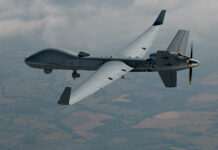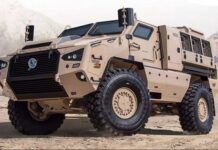Remotely controlled unmanned warfare seems to be the future in global warfare, as has been seen since World War Two where radio-controlled B-24s were used for bombing missions, to the more recent drone attacks in Afghanistan, Iraq, against Saudi oil refineries and drone-dropped explosives over an Indian Air Force base in the northern Indian border State of Jammu. Indian defence forces operate an imported mix of UAVs, including the SEARCHER Mk-2, HERONS and SEA GUARDIANS.
During Prime Minister Narendra Modi’s recent US visit, a US$3Bn deal for 30 MQ-9 REAPER drones was announced to bolster the military capability of all three services. Each of the armed services will receive ten of these drones, with special features such as the ability to be airborne for 27 hours at a stretch, and to operate at an altitude of 50,000 feet. They will also come armed with laser-guided bombs and HELLFIRE missiles.
The Indian Navy
The Indian Navy has been operating two MQ-9 SEA GUARDIAN drones (derived from the PREDATOR series) leased from the US in November 2020, for a period of one year, with an option of extending by an extra year. The SEA GUARDIANS can remain airborne for at least 30 hours and can hunt targets both at sea and land. They can also be used in high altitude border areas like eastern Ladakh. The Indian Navy’s area of responsibility extends from Madagascar to the Malacca Straits and beyond. With the soon-to-be-acquired MQ-9 REAPER UAVs, the Indian Navy will be in a position to counter the Chinese WING LOONG-II drones known for their precision strikes.
The Indian Navy has also put up a case with the Ministry of Defence to upgrade its existing fleet of three squadrons of the Israeli made SEARCHER Mk-II and HERON UAVs, which was granted approval.
The IAF Project CHEETAH
This US$800M project is known by the name Project CHEETAH and was expedited last year as the Indo-China border stand-off commenced. The project will see the Medium Altitude Long Endurance (MALE) Israeli HERONs of all three services upgraded to enable them to conduct long-range surveillance, specialised missions and precision strikes. This deal has been finalised and will be announced shortly.
IAF Air Marshal (Retd) B. Suresh says, “The case for HALE, MALE UAVs and additional AWACS has been ongoing for many years. It is not a reaction to Chinese antics. UAVs/ drones are effective in uncontested air spaces and against states which cannot or do not retaliate. No aerial vehicle can cross an International Border. That will be considered an act of war.”
Under Project CHEETAH, the HERONs operated by the three Indian services, which number approximately 200, will be upgraded and weaponised with small anti-personnel and anti-armour precision air-to-ground missiles, specialised sensors and a satellite navigation system. This will enable the HERONs to carry and launch missiles. Project CHEETAH was first proposed by the IAF in 2013, with the aim to upgrade the HERONs in service. The Navy and Army both pitched in later for optimisation. The other drone in use in the Indian Armed Forces – the SEARCHER Mk-II – cannot be weaponised due to its small size.
Project Phases
Project CHEETAH is essentially divided into two separate programmes, namely the weaponising and upgrading of the HERON drones, assisted by Israel Aerospace Industries. The cost negotiations have been concluded and the final contract is likely to be signed anytime soon. Indian Defence Secretary Ajay Kumar will embark on a short visit to Israel next month.
The IAF also operates two types of Kamikaze type drones purchased from Israel, the HARPY and the upgraded HAROP. The former can be launched from a ground vehicle, is a fire-and-forget system and operates in all weather, day and night. It also contains an autonomous weapon system used to destroy enemy radars and disable air defence systems, while the HAROP is a Loitering Missile that can destroy a number of targets, including moving vehicles.
The Indian Army
Meanwhile, the Indian Army has leased four HERON TP UAVs from Israeli IAI under a US$200M deal, designed to take care of its immediate needs, as Project CHEETAH will take time. The lease is for three years and the first two UAVs have already been delivered.
The HERON TPs will be deployed at the 3,400-km long Line of Actual Control in Ladakh, for surveillance purposes. The HERON TPs are not weaponised. The 14-m long HERON TP, with a wingspan of 26 m, can remain airborne for at least 45 hours and is fitted with Satellite Communication systems for an extended range, Automatic Taxi-Takeoff and Landing, ultra-long-range surveillance cameras and other state-of-the-art equipment.
Indigenous Industry
To provide a boost to domestic industry under the Make in India initiative, indigenous start-ups are being considered by the Indian Armed Forces. The Indian Army’s Lt. Gen Vinod Bhatia (Retd) said, “UAVs are a critical and integral part of future wars and border defence. We need critical technology in UAVs in the immediate term, while we build indigenous capabilities.”
Under the fast track acquisitions, the IAF has placed an order for a mobile anti-drone system while the Navy will also receive a similar system for its warships. Deliveries are expected within a year.
While the IAF has also shown interest, the Army has become the lead service to choose swarm drones, touted as the future of warfare, and has signed a US$30M order with Indian start-ups to supply a system capable of kinetic attacks, electronic warfare and surveillance. Indian start-ups are being referred to as the future for their low manufacturing costs, assurances of timely delivery and security. Some of the start-ups engaged by the Indian MoD include the Bangalore-based NewSpace Research, which is also working with Hindustan Aeronautics Ltd for a futuristic air-launched swarm drone system, called Combat Air Teaming System.
Start Up Opportunities
There is also the Noida-based Raphe mPhibr, awarded a contract for a load carrying UAV that can be used for supplying essentials to forward area troops and swarm drones. In addition, the Hyderabad-based Zen Tech has orders for a mobile anti-drone system for the IAF. Swarm drones are already in use in the UK, Russia, US, and China. They are multiple drones engaged in carrying out coordinated military missions.
A Navi Mumbai-based firm ideaForge Technology, boasting its SWITCH UAV as the first of its kind Vertical Take-Off and Landing aircraft and fixed wing hybrid UAV has just delivered the first batch of the 30 advanced SWITCH tactical drones to the Indian Army under an order worth US$20M placed in January 2021. These drones will be deployed at the LAC. The SWITCH weighs 6.5 kg and is capable of both vertical take-off and conventional flight. It can carry out intelligence, surveillance and reconnaissance from an altitude of 4,000 m up to 15 km, with a wind resistance up to 10.8 knots per hour.
Many private Indian firms have also come forward, but need assistance in the areas of:
- batteries (mainly high capacity Li-Po)
- high efficiency propulsion systems (motors, propellers, hybrid systems)
- robust datalinks and their algorithms (especially when talking of swarms)
- anti-spoofing or jamming technology
All these directly affect operational efficacy, endurance, range and pay load capacity.
Quadcopters
For tactical surveillance in the counter-terrorism environment, the Indian Army’s infantry battalions have been using a wide variety of quadcopters, developed and manufactured indigenously. Deployed mostly at the India-Pakistan border, these quadcopters cost no more than a few thousand Dollars.
AWACS
The IAF has been operating three Israeli PHALCON AWACS mounted on Russian IL-76 heavy-lift aircraft, with a 400 km range since 2009 with a contract for two more similar systems. This US$800M deal is close to conclusion.
In September this year, the Indian Government gave approval to the Government-owned defence research agency-Defence Research and Development Organisation (DRDO) for a project worth US$1.5Bn to develop six new Airborne Early Warning and Control (AEW&C) aircraft for the IAF. These aircraft are A321s and A-319s. They will be modified by mounting the DRDO developed indigenous Active Electronically Scanned Array (AESA) radar on them.
Better known as “eyes in the sky”, the AEW&C can detect and track all incoming drones, fighters and cruise missiles much quicker than ground-based radars. This system is also capable of acting as an aerial control room for missions and tracking ships at sea. Besides the three Israeli PHALCONs, the IAF also operates two indigenous ‘NETRA’ AEW&C systems mounted on an Embraer aircraft. AWACS and AEW&C aircraft are meant to provide air surveillance and early warning for specific missions and also in specific areas where gaps exist.
Counter-UAS
Following the drone attack at an IAF base in July this year, the three Indian armed services have signed up for the purchase of indigenous anti-drone technology from DRDO. The Government-owned Public Sector Unit Bharat Electronics Limited is poised to supply the first indigenous comprehensive anti-drone system, called D4, with both hard-kill and soft-kill capabilities, in static and mobile versions. D4 easily eliminates targets, in addition to detecting and jamming micro drones.














